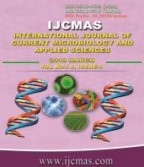


 National Academy of Agricultural Sciences (NAAS)
National Academy of Agricultural Sciences (NAAS)

|
PRINT ISSN : 2319-7692
Online ISSN : 2319-7706 Issues : 12 per year Publisher : Excellent Publishers Email : editorijcmas@gmail.com / submit@ijcmas.com Editor-in-chief: Dr.M.Prakash Index Copernicus ICV 2018: 95.39 NAAS RATING 2020: 5.38 |
The study was conducted in Junagadh and Porbandar districts of Gujarat to compare breeding, calf and health management practices opted by buffalo owners (n=300). Majority of farmers practiced natural service (59%), late heat for insemination (76.34%), pregnancy diagnosis (90%) and treatment of anoestrous/repeaters buffaloes (90.33%). Most of respondents attended calving and took care of calves after parturition (98%) and cleaned calves (93.67%). However, few farmers practiced ligation/ cutting and disinfection of navel cord (14.33%) and feeding colostrum to calf (33.33%). Such above managemental practices varied between Junagadh and Porbandar districts (Pï‚£0.05). Majority of owners dewormed their calves (71.67%), allowed to suckle (77%) one teat (91.33%) and offered greens (96.67%) or concentrate (94.67%) to calves at 3 months of age. Majority of respondents practiced vaccination (84.67%) particularly F.M.D. (68.67%), but few farmers dewormed their animals (11%). Buffalo owners cleaned water trough/ manger on every day in most cases (59.67%), but cleaned the shed on every alternate day (47.67%). Cleaning practices of waterer/ manger and shed differed statistically between the two districts (Pï‚£0.05).Majority of owners isolate sick buffaloes (87.67%), used medicine for ectoparasites (80.67%), washed hind quarter after placenta expulsion (93%) and called livestock inspector to treat their buffaloes (55.33%). Calling livestock inspector or veterinary doctors for treatment of buffaloes varied in both districts (Pï‚£0.05). Metabolic disorder was major problem in buffaloes (50.33%). Comparatively more number of owners in Porbandar reported reproductive problems but in less instance metabolic disorder than Junagadh district (Pï‚£0.05).Above results indicated that farmers were aware about different breeding, calf and health care management practices. Further, certain managerial practices also differed markedly between Junagadh and Porbandar districts.
 |
 |
 |
 |
 |